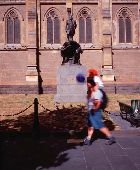Multimedia Content

Captain Matthew Flinders Statue, 1923, by Sculptor Charles Web Gilbert; founder F. Barbedienne, courtesy of City of Melbourne.
Details
Captain Matthew Flinders Statue
Sculptor Charles Web Gilbert; founder F. Barbedienne
Bronze statue with granite plinth
1923
St Paul's Cathedral, Swanston Street
Charles Web Gilbert was born in 1867 near Cockatoo, in Victoria. At a young age he became a pastry cook, modelling cake decorations. He later studied at the National Gallery Art School, but had no formal training in sculpture. Gilbert travelled to England at the outbreak of World War I, and shortly after to France, where he made battlefield models for the Australian Imperial Force. Returning to Australia, he worked for the Australian War Memorial, and later undertook many commemorative commissions. The Flinders monument is Gilbert's best-known work and has been particularly admired for the use of the boat as the statue's base.
Flinders gained acclaim for establishing the strait between mainland Australia and Tasmania in 1798. Over 1801-03, he mapped the coast of Australia, completed against great odds, and was the first cartographer to use 'Australia' on maps, rather than 'New Holland'. On the Flinders' Statue Fund collecting card, Professor Ernest Scott wrote: 'amongst the seamen who habitually traverse these coasts, no name, not even that of Cook, is so deeply esteemed as his'.
